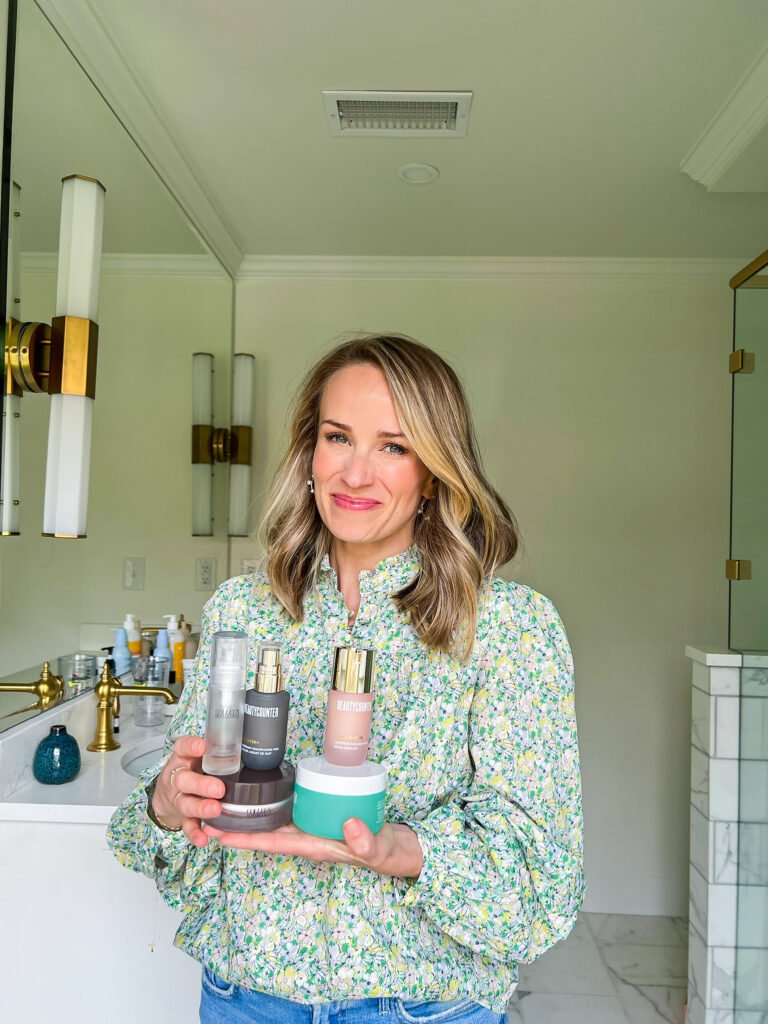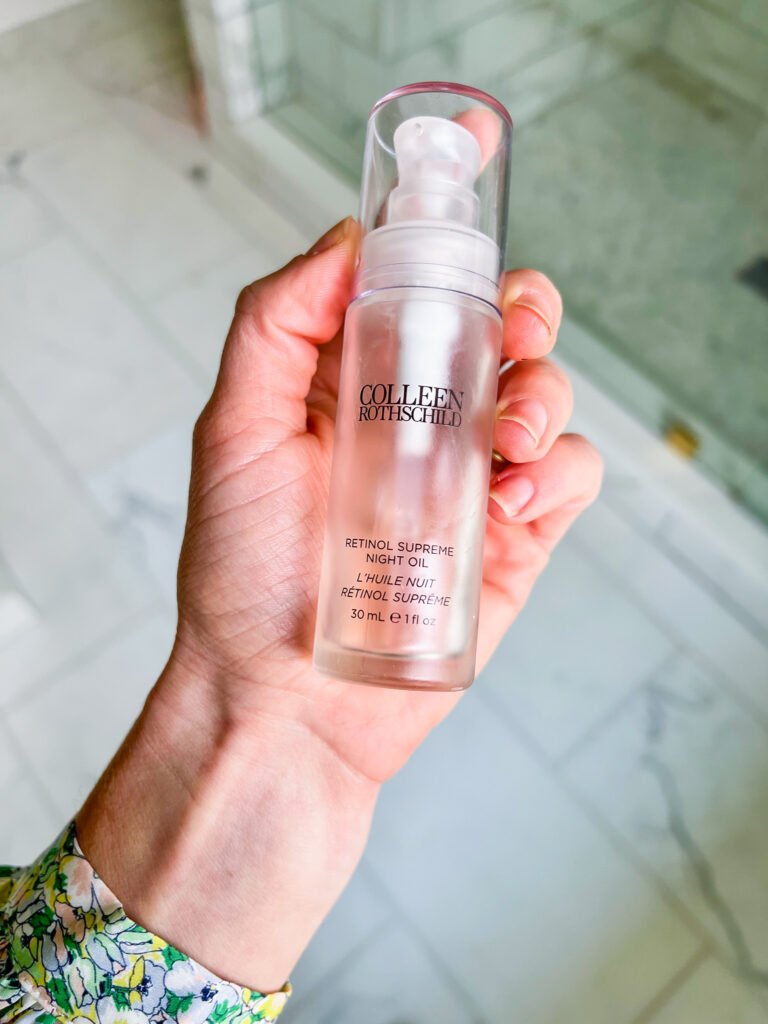

As a self proclaimed makeup and skincare junkie, I LOVE to try new products. And as someone who’s worked in the skincare and makeup industry for about 7 years (on the sales side), I’ve also learned a ton about the science of skincare. I don’t know everything, and I’m not a licensed esthetician, but I love to share what has worked for me.
I get asked about my skincare routine almost every single time I post a selfie on Instagram, and each time, I’m so flattered. My skin hasn’t always been in great shape (I struggled with severe acne in my twenties), so when someone thinks it looks good enough to ask for recommendations, it’s a reminder of how far I’ve come. My skin truly looks better at almost 40 than it did in my 20s.
One of the most effective things I done for my skin is called skin cycling. In today’s post I’m going to share what skin cycling is and how I do it with my skincare routine.

Skin Cycling is essentially rotating the treatment or product you’re using on your skin each night, so that you’re in a rhythm of using active ingredients for a few days, and then following that up with recovery days where your skin gets to rest.
“It’s a four-night cycling schedule: exfoliation night, retinoid night, recovery night, recovery night, repeat. You will get the most out of the active ingredients in your skin-care products while minimizing irritation by building in those needed recovery nights,” Dr. Bowe explains. (source)
I loosely follow a skincare cycle routine myself. It helps so my skin isn’t over-treated, which often leads to redness, irritation, or breakouts (I actually break out if my skin is too dry). I also alternate some of the pricier products with more affordable ones so my super expensive products last longer.
Here’s how my basic skincare cycle works:
And then I repeat the cycle.
My Exfoliate/Retinol/Recovery step is always the third step in my full skincare routine each night, as outlined below. (You can see my full skincare routine here.)
Since I work in the beauty influencer industry, I’m so lucky that I get a lot of products sent to me! (And, let’s be honest, I’m also guilty of still buying a fair amount of products!) I often get asked how I fit new products into my routine, and I simply replace one of my usual products with the new product on the appropriate day for a few weeks to see if it makes the cut!

Exfoliate with peel pads. I switch between iS Clinical Peel pads (more aggressive, I have a full review of the iS Clinical Peel Pads with details on the blog) – review here) and the Colleen Rothschild peel pads, which are better for sensitive skin.
I’ve been using the Colleen Rothschild peel pads throughout my pregnancy and breastfeeding journey because I know the ingredients they use are all pregnancy safe (except their Retinol Oil). iS Clinical says theirs are safe too, but since I know Colleen Rothschild products a bit better, I just stick to those.
Beautycounter Overnight Resurfacing Peel – This is a retinal alternative and what I’ve been using for the last year during pregnancy and now breastfeeding. It contains AHA and BHA which helps skin texture and boosts clarity without irritation or over-drying. It also has glycolic, malic, and botanically derived lactic acid, which all help slough dead skin cells to give you a brighter complexion. It’s gentle but effective, and I’d argue it’s just as good as retinol. ALL Beautycounter products are safe for pregnancy and breastfeeding.
Read my review of the Overnight Resurfacing Peel here.
When I’m not pregnant or breastfeeding, I use the Colleen Rothschild Retinol Supreme Night Oil. This contains vitamin C, so it’s a total powerhouse. It helps improve skin texture and cell turnover, while also brightening dark spots. And it’s much better for sensitive skin than a typical retinol since this is in oil form. This is the first retinol I’ve actually liked since I noticed a difference but didn’t experience peeling. (If you are struggling with peeling, read this post.)

I LOVE this SkinMedica Serum. It’s pricey, but it’s a clinical-grade anti-aging serum that targets fine lines, deep wrinkles and sagging skin. I have noticed my skin feels more taut and smoother after using this for just a few weeks. This is more hydrating than my other night time serums, so I treat this day like a skin “recovery day”. (Full review of the SkinMedica Serum here.) If I don’t have that on hand, I use the Radiance Serum below.
I let my skin recover another day and use the Beautycounter Countertime Tripeptide Radiance Serum.

The next day, I’ll exfoliate. I use either the Beautycounter AHA Reflect Effect Mask or the Colleen Rothschild Enzyme Polish. I love both, but I do think the Beautycounter AHA mask is more potent than the Colleen Rothschild mask so if you have sensitive skin, keep that in mind. If I don’t feel like doing a mask (which is most of the time!), I’ll simply use this exfoliating polish in the shower (I mix it with my cream cleanser).

Retinol or retinol alternative again. Either the Beautycounter Overnight Peel or the Colleen Rothschild Retinol Supreme Night Oil (use TERILYN20 for 20% off Colleen Rothschild products).
Recovery day after retinol. I use the SkinMedica Serum.
One more day of recovery. I’ll typically use the Beautycounter Countertime Tripeptide Radiance Serum which helps with signs of aging but is gentle and soothing.
If you’re new to anti-aging skincare (especially retinol), following a skincare cycle like this can help minimize irritation since so many people (myself included) are prone to jump in with a new product and use it everyday rather than gradually building up tolerance to it. Not only is this approach better for skin, it’s better for your budget since you don’t need to use your most expensive skincare everyday to still see great results.
I know that a skin cycle routine can be a little overwhelming, so I’ve put together a PDF that you can print out to keep you on track. Drop your email here and I’ll send the PDF to your inbox.
Let me know if you have any questions!
Shop The Post


Notifications
Leave a Comment